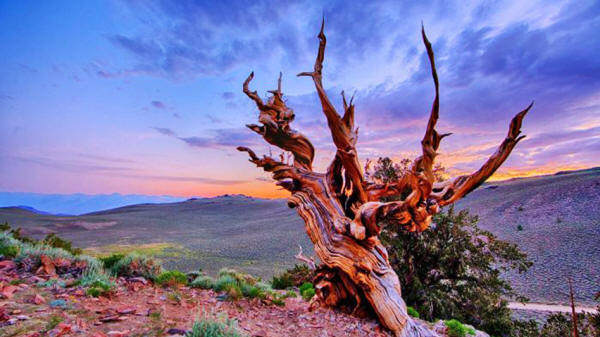Storyline
In
the arid and inhospitable California desert stands a
bristlecone pine tree (Pinus
longaeva)
with the mythical name of
Methuselah.
At
nearly 5,000 years of age, it had long been thought to
be the oldest living organism on our planet.
Pre-dating the construction of the pyramids and the
birth of Christ, the tree is a marvel of resilience and
survival.
"The
Curse of the Methuselah Tree" attempts to deconstruct
its long and complex history.
The most unique aspect of the film is its point of view.
Much of the narration consists of sumptuous poetry
provided by Roger McGough.
Assuming the role of the
tree, this lyrical inner monologue deepens our sense of
empathy and engagement with the scope of events detailed
in the film.
For much of its life span, the mysteries of this
extraordinary tree eluded us.
It
wasn't until Edmund Schulman, a pioneer in tree aging,
first discovered Methuselah in the 1950s that the
scientific community began to take notice.
Studying the endless layers of inner rings housed under
its bark, Schulman was able to assemble a detailed
account of the tree's rich and eventful existence.
These rings convey stories of,
-
calamitous weather events
-
civilizations come and gone
-
nuclear tests that set
the desert ablaze with furious plumes of fire and
diseased smoke
The
film reenacts many of these events in visceral detail,
including,
-
the emergence of ancient Indians to the
region
-
the arrival of white immigrants soon after
-
the actions of industry that choked the desert of
much of its resources
When the seedlings of the tree's bristlecones were
examined in a lab, they showed no signs of
deterioration.
From outside appearances, the tree might
strike spectators as nothing more than a weakened and
twisted mass. But upon closer inspection, it's as vital
and robust as the day it was born.
"The Curse of the Methuselah Tree" is an impressive and
multi-layered work.
The
history of this mystical tree reflects much of our own
history in a manner that sets it apart from other
documentaries that cover similar events.
The
film's conclusion is equally distinct as it delivers an
unexpectedly vivid and harrowing environmental
statement.
Source


